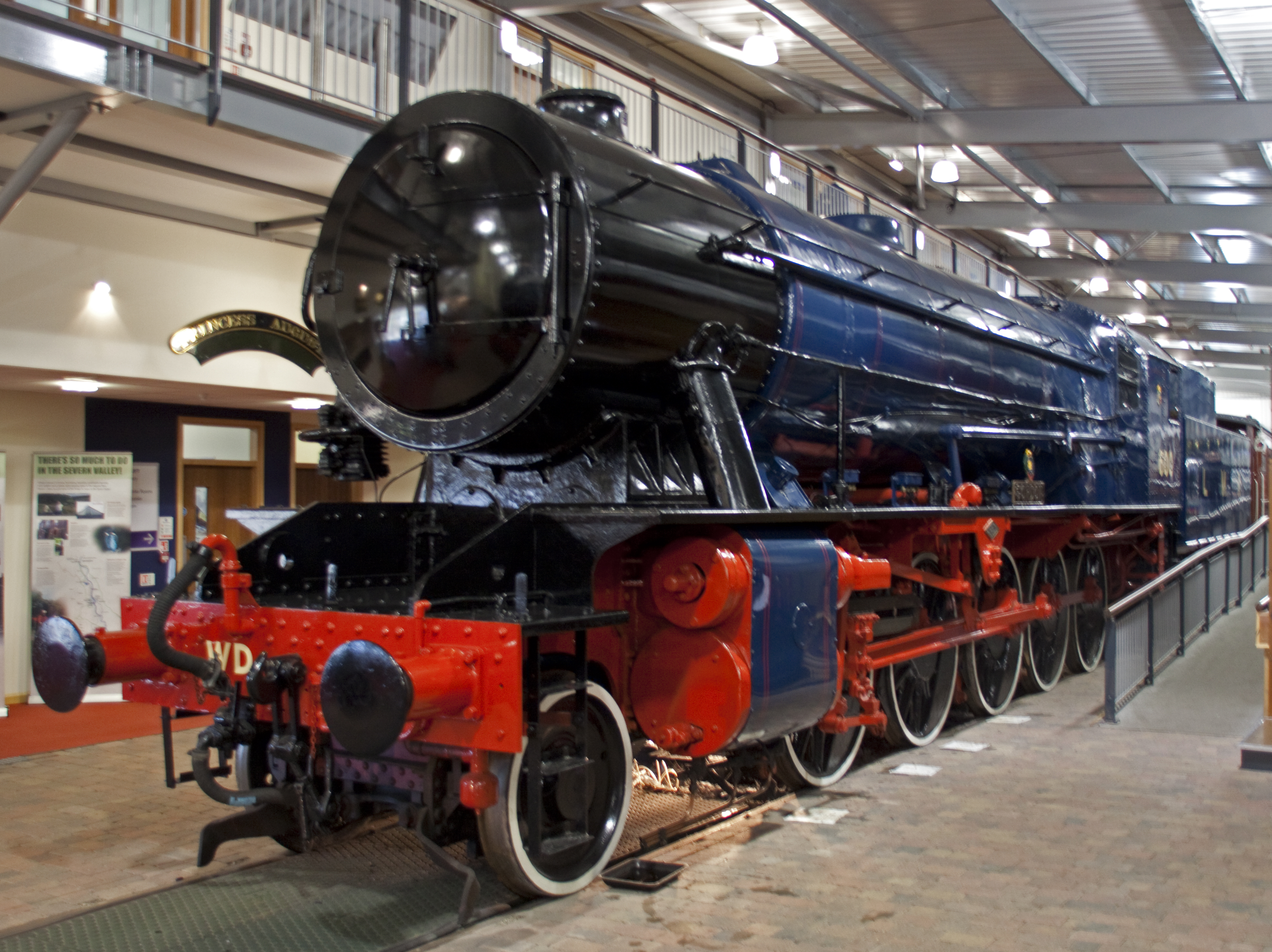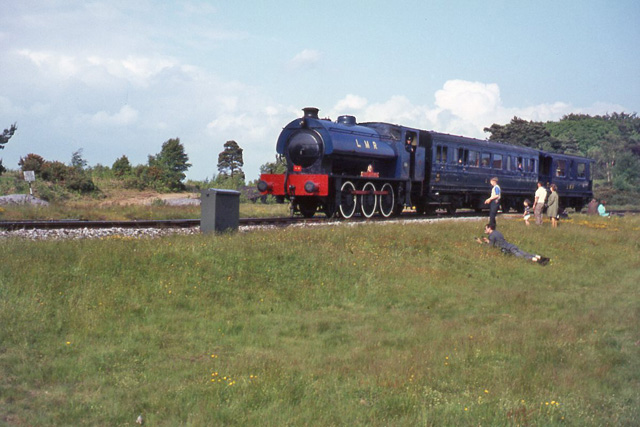|
LMR 600 Gordon
Longmoor Military Railway number 600 ''Gordon'' is a preserved British steam locomotive. It was built during World War II to the War Department "Austerity" 2-10-0 design and was the last steam locomotive owned by the British Army. It had the same power output as the Austerity 2-8-0 but a lighter axle load, making it suitable for secondary lines. The middle driving wheels of the class have no flange, to ease turning on tighter tracks. Service Gordon was the second of 150 2-10-0 locomotives built for the War Department by the North British Locomotive Co. at its Hyde Park Works in Glasgow. The locomotive entered service in December 1943 as No. 3651, shortly afterward becoming No. 73651 when the instruction was given during 1944 to increase WD numbers by 70,000. Although most of the first batch of 100 saw service overseas, Gordon remained in the UK throughout the War. After the War, the locomotive was used by the Royal Engineers on the Longmoor Military Railway in Hampshir ... [...More Info...] [...Related Items...] OR: [Wikipedia] [Google] [Baidu] |
Longmoor Military Railway
The Longmoor Military Railway (LMR) was a British military railway in Hampshire, built by the Royal Engineers from 1903 in order to train soldiers on railway construction and operations. The railway ceased operation on 31 October 1969. Route Authorised for construction from 1902, activities date from 1903 when an gauge tramway was laid to assist in removing 68 large corrugated iron huts from Longmoor Military Camp to Bordon. The railway was relaid to standard gauge in 1905–1907 and was initially known as the Woolmer Instructional Military Railway. It was renamed the ''Longmoor Military Railway'' in 1935. The Liss extension was opened in 1933. The stations and junctions included: *Bordon – the northern terminal, adjacent to Bordon station and with access to British Railways via the LSWR owned Bentley and Bordon Light Railway. * Oakhanger Halt - serving the village of Oakhanger, Hampshire. Bordon station was nearer to Oakhanger and Oakhanger station was nearer to Bordon ... [...More Info...] [...Related Items...] OR: [Wikipedia] [Google] [Baidu] |
Flange
A flange is a protruded ridge, lip or rim (wheel), rim, either external or internal, that serves to increase shear strength, strength (as the flange of an iron beam (structure), beam such as an I-beam or a T-beam); for easy attachment/transfer of contact force with another object (as the flange on the end of a pipe (fluid conveyance), pipe, steam cylinder, etc., or on the lens mount of a camera); or for stabilizing and guiding the movements of a machine or its parts (as the inside flange of a railroad car, rail car or tram train wheel, wheel, which keep the wheels from derailment, running off the rail profile, rails). Flanges are often attached using bolts in the pattern of a bolt circle. The term "flange" is also used for a kind of tool used to form flanges. Plumbing or piping A flange can also be a plate or ring to form a rim at the end of a pipe when fastened to the pipe (for example, a closet flange). A blind flange is a plate for covering or closing the end of a pipe. A ... [...More Info...] [...Related Items...] OR: [Wikipedia] [Google] [Baidu] |
Preserved Steam Locomotives Of Great Britain
Preservation may refer to: Heritage and conservation * Preservation (library and archival science), activities aimed at prolonging the life of a record while making as few changes as possible * ''Preservation'' (magazine), published by the National Trust for Historic Preservation * Historic preservation, endeavor to preserve, conserve and protect buildings, objects, landscapes or other artifacts * Conservation and restoration of cultural heritage, protection and care of tangible cultural heritage Mathematics and computer science * Type preservation, property of a type system if evaluation of expressions does not cause their type to change * Case preservation, when computer storage preserves the distinction between upper and lower case * Digital preservation, endeavor to ensure that digital information of continuing value remains accessible and usable Arts and entertainment * ''Preservation'' (2018 novel), historical fiction by Jock Serong about the wreck of the '' Sydney ... [...More Info...] [...Related Items...] OR: [Wikipedia] [Google] [Baidu] |
Thomas The Tank Engine & Friends
''Thomas & Friends'' (originally known as ''Thomas the Tank Engine & Friends'' and later ''Thomas & Friends: Big World! Big Adventures!'') is a British children's television series that aired across 24 series from 1984 to 2021. Based on ''The Railway Series'' books by Rev. W. Awdry and his son Christopher, the series was developed for television by Britt Allcroft. The series follows the adventures of Thomas, an anthropomorphised blue steam locomotive on the fictional North Western Railway on the Island of Sodor, and several other anthropomorphised locomotives on the North Western Railway, including Edward, Henry, Gordon, James, Percy, and Toby. They work for the Fat Controller, who always wants his engines to be "really useful". In the United States, it was first broadcast along with the spin-off series ''Shining Time Station'' on PBS' PTV Park block in 1989. The rights to the series are currently owned by HIT Entertainment (a subsidiary of Mattel), which acquired Gullane Ent ... [...More Info...] [...Related Items...] OR: [Wikipedia] [Google] [Baidu] |
Gordon The Big Engine
This article is about the characters that have appeared in the books of ''The Railway Series'' by the Rev. Wilbert Awdry and Christopher Awdry. Unless otherwise stated on this page, the technical notes come from actual notes laid out by Wilbert Awdry when he was developing the characters and setting for his stories; these notes are cited in his publication ''The Island of Sodor: Its People, History, and Railways''. North Western Railway These are the main rolling stock of the North Western Railway (NWR), commonly referred to as the Fat Controller's railway: Steam engines The Eight Famous Engines =Thomas (Number 1)= ''Thomas'' is a blue ex-London, Brighton and South Coast Railway E2 class locomotive. =Edward (Number 2)= ''Edward'' is an old blue ex-Furness Railway K2 class locomotive. He is the first character to appear in ''The Railway Series''. =Henry (Number 3)= ''Henry'' was originally a designed by Sir Nigel Gresley. He was built circa 1919 and arrived on Sod ... [...More Info...] [...Related Items...] OR: [Wikipedia] [Google] [Baidu] |
Suez Crisis
The Suez Crisis, or the Second Arab–Israeli war, also called the Tripartite Aggression ( ar, العدوان الثلاثي, Al-ʿUdwān aṯ-Ṯulāṯiyy) in the Arab world and the Sinai War in Israel,Also known as the Suez War or 1956 War; other names include the ''Sinai war'', ''Suez–Sinai war'', ''1956 Arab–Israeli war'', the Second Arab–Israeli war, ''Suez Campaign'', ''Sinai Campaign'', ''Kadesh Operation'' and ''Operation Musketeer'' was an invasion of Egypt in late 1956 by Israel, followed by the United Kingdom and France. The aims were to regain control of the Suez Canal for the Western powers and to remove Egyptian president Gamal Abdel Nasser, who had just swiftly nationalised the foreign-owned Suez Canal Company, which administered the canal. Israel's primary objective was to re-open the blocked Straits of Tiran. After the fighting had started, political pressure from the United States, the Soviet Union and the United Nations led to a withdrawal by the ... [...More Info...] [...Related Items...] OR: [Wikipedia] [Google] [Baidu] |
Charles George Gordon
Major-general (United Kingdom), Major-General Charles George Gordon Companion of the Order of the Bath, CB (28 January 1833 – 26 January 1885), also known as Chinese Gordon, Gordon Pasha, and Gordon of Khartoum, was a British Army officer and administrator. He saw action in the Crimean War as an officer in the British Army. However, he made his military reputation in Qing Dynasty#Rebellion, unrest and external pressure, China, where he was placed in command of the "Ever Victorious Army", a force of Chinese soldiers led by European officers which was instrumental in putting down the Taiping Rebellion, regularly defeating much larger forces. For these accomplishments, he was given the nickname "Chinese Gordon" and honours from both the Emperor of China and the British. He entered the service of the Isma'il Pasha, Khedive of Egypt in 1873 (with British government approval) and later became the List of governors of pre-independence Sudan, Governor-General of the Sudan, where he di ... [...More Info...] [...Related Items...] OR: [Wikipedia] [Google] [Baidu] |
Royal Engineers
The Corps of Royal Engineers, usually called the Royal Engineers (RE), and commonly known as the ''Sappers'', is a corps of the British Army. It provides military engineering and other technical support to the British Armed Forces and is headed by the Chief Royal Engineer. The Regimental Headquarters and the Royal School of Military Engineering are in Chatham in Kent, England. The corps is divided into several regiments, barracked at various places in the United Kingdom and around the world. History The Royal Engineers trace their origins back to the military engineers brought to England by William the Conqueror, specifically Bishop Gundulf of Rochester Cathedral, and claim over 900 years of unbroken service to the crown. Engineers have always served in the armies of the Crown; however, the origins of the modern corps, along with those of the Royal Artillery, lie in the Board of Ordnance established in the 15th century. In Woolwich in 1716, the Board formed the Royal Regime ... [...More Info...] [...Related Items...] OR: [Wikipedia] [Google] [Baidu] |
Glasgow
Glasgow ( ; sco, Glesca or ; gd, Glaschu ) is the most populous city in Scotland and the fourth-most populous city in the United Kingdom, as well as being the 27th largest city by population in Europe. In 2020, it had an estimated population of 635,640. Straddling the border between historic Lanarkshire and Renfrewshire, the city now forms the Glasgow City Council area, one of the 32 council areas of Scotland, and is governed by Glasgow City Council. It is situated on the River Clyde in the country's West Central Lowlands. Glasgow has the largest economy in Scotland and the third-highest GDP per capita of any city in the UK. Glasgow's major cultural institutions – the Burrell Collection, Kelvingrove Art Gallery and Museum, the Royal Conservatoire of Scotland, the Royal Scottish National Orchestra, Scottish Ballet and Scottish Opera – enjoy international reputations. The city was the European Capital of Culture in 1990 and is notable for its architecture, cult ... [...More Info...] [...Related Items...] OR: [Wikipedia] [Google] [Baidu] |
North British Locomotive Co
The North British Locomotive Company (NBL, NB Loco or North British) was created in 1903 through the merger of three Glasgow locomotive manufacturing companies; Sharp, Stewart and Company (Atlas Works), Neilson, Reid and Company (Hyde Park Works) and Dübs and Company (Queens Park Works), creating the largest locomotive manufacturing company in Europe and the British Empire. Its main factories were located at the neighbouring Atlas and Hyde Park Works in central Springburn, as well as the Queens Park Works in Polmadie. A new central Administration and Drawing Office for the combined company was completed across the road from the Hyde Park Works on Flemington Street by James Miller (architect), James Miller in 1909, later sold to Glasgow Corporation in 1961 to become the main campus of North Glasgow College (now Glasgow Kelvin College). The two other Railway works in Springburn were St. Rollox railway works, owned by the Caledonian Railway and Cowlairs railway works, owned by t ... [...More Info...] [...Related Items...] OR: [Wikipedia] [Google] [Baidu] |



.jpg)
